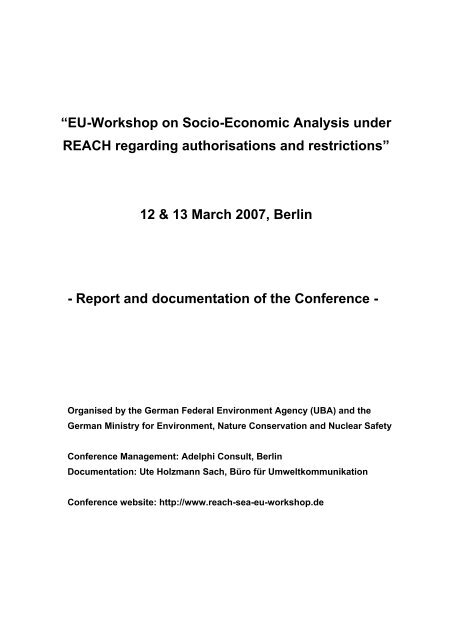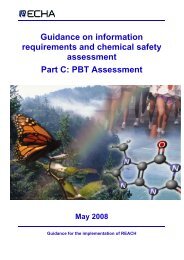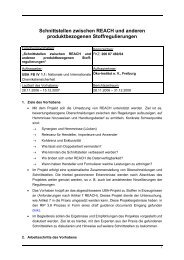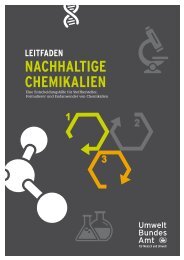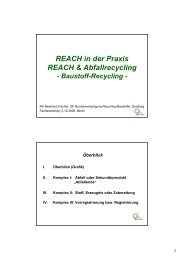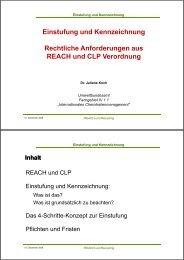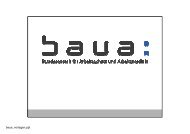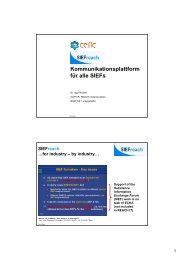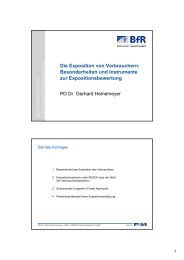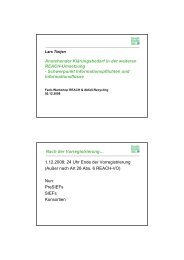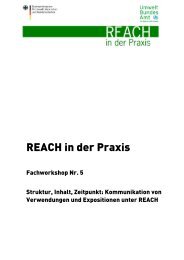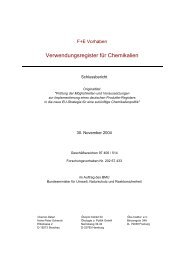“EU-Workshop on Socio-Economic Analysis under REACH ...
“EU-Workshop on Socio-Economic Analysis under REACH ...
“EU-Workshop on Socio-Economic Analysis under REACH ...
You also want an ePaper? Increase the reach of your titles
YUMPU automatically turns print PDFs into web optimized ePapers that Google loves.
<str<strong>on</strong>g>“EU</str<strong>on</strong>g>-<str<strong>on</strong>g>Workshop</str<strong>on</strong>g> <strong>on</strong> <strong>Socio</strong>-Ec<strong>on</strong>omic <strong>Analysis</strong> <strong>under</strong><br />
<strong>REACH</strong> regarding authorisati<strong>on</strong>s and restricti<strong>on</strong>s”<br />
12 & 13 March 2007, Berlin<br />
- Report and documentati<strong>on</strong> of the C<strong>on</strong>ference -<br />
Organised by the German Federal Envir<strong>on</strong>ment Agency (UBA) and the<br />
German Ministry for Envir<strong>on</strong>ment, Nature C<strong>on</strong>servati<strong>on</strong> and Nuclear Safety<br />
C<strong>on</strong>ference Management: Adelphi C<strong>on</strong>sult, Berlin<br />
Documentati<strong>on</strong>: Ute Holzmann Sach, Büro für Umweltkommunikati<strong>on</strong><br />
C<strong>on</strong>ference website: http://www.reach-sea-eu-workshop.de
Table of c<strong>on</strong>tent<br />
I. Participants<br />
II. Programme<br />
III. Reports and Statements – Short introducti<strong>on</strong>s<br />
IV. Report and Statements – Summaries<br />
V. Discussi<strong>on</strong><br />
Page<br />
VI. C<strong>on</strong>clusi<strong>on</strong>s 33<br />
ii<br />
1<br />
8<br />
11<br />
15<br />
27
I Participants<br />
More than 120 experts from all over Europe attended the workshop. They were<br />
representatives of ministries and administrati<strong>on</strong>s, the EU-Commissi<strong>on</strong>, companies,<br />
NGOs and research organisati<strong>on</strong>s.<br />
No. Title First Name Surname Organisati<strong>on</strong> City Country<br />
1 Pasi Ahde Chemical Industry<br />
Federati<strong>on</strong> of Finland<br />
Helsinki Finland<br />
2 Magarita Alexandrova Ministry of Ec<strong>on</strong>omy and<br />
Energy<br />
Sofia Bulgaria<br />
3 Dr. Reiner Arndt Ministry for the<br />
Envir<strong>on</strong>ment, Nature<br />
C<strong>on</strong>servati<strong>on</strong> and<br />
Nuclear Safety<br />
B<strong>on</strong>n Germany<br />
4 Paul N.E. Arnoldus European Commissi<strong>on</strong> Brussels Belgium<br />
5 Dr. John Athert<strong>on</strong> Internati<strong>on</strong>al Council <strong>on</strong> L<strong>on</strong>d<strong>on</strong> United<br />
Mining and Metals<br />
Kingdom<br />
6 Maria Barata Ministério da Ec<strong>on</strong>omia e Lisboa Portugal<br />
Teresa<br />
Inovação<br />
7 Dr. Henri Bastos AFSSET Mais<strong>on</strong>s-Alfort<br />
cedex<br />
FRANCE<br />
8 Eva Becker Federal Envir<strong>on</strong>ment Dessau Germany<br />
Christine<br />
Agency<br />
9 Dr. Roland Berger Goldschmidt GmbH Essen Germany<br />
10 Dr. Christopher Blum Federal Envir<strong>on</strong>ment<br />
Agency<br />
Dessau Germany<br />
11 Anja Boersma RIVM Bilthoven Netherlands<br />
12 Urban Boije af Swedish Chemicals Sundbyberg Sweden<br />
Gennäs Agency<br />
13 Dr. Holger Burmeister AllessaChemie GmbH Frankfurt Germany<br />
14 Dr. Alberto Camacho GTZ B<strong>on</strong>n Germany<br />
15 Manuel Carbo Ministry of the<br />
Envir<strong>on</strong>ment<br />
Madrid Spain<br />
16 Frans Christensen European Commissi<strong>on</strong>,<br />
DG JRC, IHCP,<br />
European Chemicals<br />
Bureau (ECB)<br />
Ispra Italy<br />
17 Dr. Alessandra Colombo Polimeri Europa S.p.A. San D<strong>on</strong>ato Italy<br />
ENI Group<br />
Milanese (MI)<br />
1
18 Catheline Dantinne Federal Public Service<br />
Health, Food chain safety<br />
and Envir<strong>on</strong>ment<br />
Brussels Belgium<br />
19 Dr. Lars Drake Swedish Chemicals<br />
Agency<br />
Sundbyberg Sweden<br />
20 Agata Drewniak Polish Chamber of<br />
Chemical Industry<br />
Warsaw Poland<br />
21 Sabine Dröge infraserv-höchst Frankfurt Germany<br />
22 Françoise Duplat Orgalime - The European<br />
Engineering Industry<br />
Associati<strong>on</strong><br />
23 Raina Dureja The Associati<strong>on</strong> of<br />
Latvian Chemical and<br />
Pharmaceutical Industry<br />
Brussels Belgium<br />
Riga Latvia<br />
24 Elina Karhu European Commissi<strong>on</strong> Bruxelles Belgique<br />
25 Jose Elorrieta Directi<strong>on</strong> General for Madrid Spain<br />
Ignacio<br />
Envir<strong>on</strong>mental Quality<br />
and Impact Assessment<br />
26 Henrik Eriksen Ministry of the<br />
Oslo Norway<br />
Hallgrim<br />
Envir<strong>on</strong>ment<br />
27 Sim<strong>on</strong>e Fankhauser Umweltbundesamt Vienna Austria<br />
28 Francis E. Farrugia Malta Standards<br />
Authority<br />
Valletta Malta<br />
29 Jean-Pierre Feyaerts Federal Public Service<br />
Ec<strong>on</strong>omy, SME's,<br />
Selfemployed and<br />
Energy<br />
Brussels Belgium<br />
30 Lars Fock Danish Envir<strong>on</strong>mental<br />
Protecti<strong>on</strong> Agency<br />
Copenhagen Danmark<br />
31 Birgit Fremault Federati<strong>on</strong> of enterprises<br />
in Belgium<br />
Brussels Belgium<br />
32 Antje Freriks Federal Envir<strong>on</strong>ment<br />
Agency<br />
Dessau Germany<br />
33 Lisbeth Frisenborg DHI Wasser & Umwelt Stuttgart Germany<br />
34 Dr. Takashi Furukawa Sumitomo Chemical<br />
Europe S.A./N.V.<br />
35 Tomas Gärdström Swedish Agency for<br />
Ec<strong>on</strong>omic and Regi<strong>on</strong>al<br />
Growth<br />
36 Dr. Sabine Gärtner Ministry for the<br />
Envir<strong>on</strong>ment, Nature<br />
Machelen Belgium<br />
Stockholm Sweden<br />
B<strong>on</strong>n Germany<br />
2<br />
2
37 Dr. Magda Gáspárné<br />
C<strong>on</strong>servati<strong>on</strong> and<br />
Nuclear Safety<br />
Hungarian Chemical Budapest Hungary<br />
bada Industry Associati<strong>on</strong><br />
38 Dr. Carl Otto Gensch Institute for Applied<br />
Ecology (Öko-Institut)<br />
Freiburg Germany<br />
39 Dr. Aurélien Genty INERIS Verneuil-en-<br />
Halatte<br />
France<br />
40 Dr. Stelios Georghiades Ministry of Labour and<br />
Social Insurance<br />
Nicosia Cyprus<br />
41 Sebastian Gil European Commissi<strong>on</strong> Brussels Belgium<br />
42 Hermann Götsch Bundesministerium für<br />
Land- und<br />
Forstwirtschaft, Umwelt<br />
und Wasserwirtschaft<br />
Vienna Austria<br />
43 Dr. Petra Greiner Federal Envir<strong>on</strong>ment<br />
Agency<br />
Dessau Germany<br />
44 Karola Grodzki European Commissi<strong>on</strong> Brussels Belgium<br />
45 Gregor Grüttner Adelphi C<strong>on</strong>sult Berlin Germany<br />
46 Eva Gustafss<strong>on</strong> Swedish Chemicals<br />
Agency<br />
Sundbyberg Sweden<br />
47 Mari<strong>on</strong> Haese GTZ B<strong>on</strong>n Germany<br />
48 Dr. Nadia Haiama Greenpeace Brussels Belgium<br />
49 Martin Hajaš Centre for Chemical<br />
Substances and<br />
Preparati<strong>on</strong>s<br />
Bratislava 212 Slovakia<br />
50 Anne Hawxwell Federal Ministry for the<br />
Envir<strong>on</strong>ment<br />
B<strong>on</strong>n Germany<br />
51 Dr. Mª Dolores Hernando University of Alcalá de Alcalá de Spain<br />
Guil<br />
Henares-INIA<br />
Henares,<br />
Madrid<br />
52 Dr. Rolf Hertel Bundesinstitut für<br />
Risikobewertung<br />
Berlin Germany<br />
53 Dr. Kai Höpker Landesanstalt für<br />
Umwelt, Messungen und<br />
Naturschutz Baden-<br />
Württemberg<br />
Karlsruhe Germany<br />
54 Dr. Keith Huckle Dow Corning Europe<br />
S.A.<br />
Senffe Belgium<br />
55 Eliisa Irpola Envir<strong>on</strong>ment Institute<br />
(SYKE)<br />
Helsinki Finland<br />
3<br />
3
56 Fip Jannpeter BASF AG Ludwigshafen Germany<br />
57 Hanna Kilen Polish Chamber Of<br />
Chemical Industry<br />
Warszawa Poland<br />
58 Dr. Sanghun Kim KIST Europe Saarbruecken Germany<br />
59 Kalle Kivelä Nati<strong>on</strong>al Product C<strong>on</strong>trol<br />
Agency for Welfare and<br />
Health (STTV)<br />
Helsinki Finland<br />
60 Astrid Klug Ministry for the<br />
Envir<strong>on</strong>ment, Nature<br />
C<strong>on</strong>servati<strong>on</strong> and<br />
Nuclear Safety<br />
Berlin Germany<br />
61 Jan-Uwe Klüssendorf BASF AG, Corporate &<br />
Governmental Relati<strong>on</strong>s,<br />
Brussels Office<br />
Brussels Belgium<br />
62 Dr. Juliane Koch Federal Envir<strong>on</strong>ment<br />
Agency<br />
Dessau Germany<br />
63 Dr. Volker Koch Clariant Produkte<br />
(Deutschland) GmbH<br />
Sulzbach Germany<br />
64 René Korenromp Ministry of Housing, Den Haag The<br />
Spatial Planning and the<br />
Envir<strong>on</strong>ment<br />
Netherlands<br />
65 Petra Krug Adelphi C<strong>on</strong>sult Berlin Germany<br />
66 Espen Langtvet Norwegian polluti<strong>on</strong><br />
c<strong>on</strong>trol authority<br />
Oslo Norway<br />
67 Lothar Lißner Kooperati<strong>on</strong>sstelle<br />
Hamburg (Behörde für<br />
Wissenschaft und<br />
Forschung, Freie und<br />
Hansestadt Hamburg)<br />
Hamburg Germany<br />
68 Heike Lueskow Ökopol GmbH Hamburg Germany<br />
69 Dr. Bettina Mach Bruno Bock Chemische<br />
Fabrik GmbH & Co KG<br />
Marschacht Germany<br />
70 Ilaria Malerba Federchimica Milano Italy<br />
71 Dr. Giuseppe Malinverno SOLVAY S.A. Milano Italy<br />
72 Marc Sapir ETUI-REHS Brussels Belgium<br />
73 Jose M. Mata Bravo Repsol YPF Móstoles<br />
(Madrid)<br />
Spain<br />
74 Eileen Maternowski Adelphi C<strong>on</strong>sult Berlin Germany<br />
75 Karola Maxianova Korea Envir<strong>on</strong>mental<br />
Council in Europe<br />
Brussels Belgium<br />
4<br />
4
76 Dr. Henrik Meincke VCI Frankfurt Germany<br />
77 Martin Mogensen Envir<strong>on</strong>mental<br />
Copenhagen Denmark<br />
Frank<br />
Assessment Institute V<br />
78 Mechthild Naschke EEB - European<br />
Envir<strong>on</strong>mental Bureau<br />
Brussel Belgium<br />
79 Wolfgang Nenno Federal Envir<strong>on</strong>ment<br />
Agency<br />
Dessau Germany<br />
80 Uffe Nielsen Envir<strong>on</strong>mental<br />
Assessment Institute<br />
Copenhagen Denmark<br />
81 Edita Nováková Ministry of Ec<strong>on</strong>omy of Bratislava Slovak<br />
the Slovak Republic<br />
Republic<br />
82 Ileana Nutu Nati<strong>on</strong>al Agency for Bucharest Romania<br />
Claudia<br />
Dangerous Substances<br />
and Preparati<strong>on</strong>s<br />
83 DaeYoung Park Korea Envir<strong>on</strong>mental<br />
Council in Europe<br />
Brussels Belgium<br />
84 Patricia Camer<strong>on</strong> BUND - Friends of the<br />
Earth Germany<br />
Berlin Germany<br />
85 Patrick Zweers Nati<strong>on</strong>al Institute for Bilthoven The<br />
Public Health and the<br />
Envir<strong>on</strong>ment (RIVM)<br />
Netherlands<br />
86 Meg Postle Risk and Policy Analysts L<strong>on</strong>d<strong>on</strong> United<br />
Ltd (RPA)<br />
Kingdom<br />
87 Dr. Steffi Richter Federal Envir<strong>on</strong>ment<br />
Agency<br />
Dessau Germany<br />
88 Dr. John Roberts Department for<br />
L<strong>on</strong>d<strong>on</strong> United<br />
Envir<strong>on</strong>ment, Food and<br />
Rural Affairs<br />
Kingdom<br />
89 Dr. Roland Schröder Henkel KGaA Düsseldorf Germany<br />
90 Dr. Eckehard Rosenbaum Federal Ministry of<br />
Ec<strong>on</strong>omics and<br />
Technology<br />
B<strong>on</strong>n Germany<br />
91 Izabela Rydlewska- Nofer Institute of<br />
Lodz Poland<br />
Liszkowska Occupati<strong>on</strong>al Medicine<br />
92 Dr. Peter Saling BASF Ludwigshafen Germany<br />
93 Andrew Scarsbrook DEFRA L<strong>on</strong>d<strong>on</strong> UK<br />
94 Dr. Beatrice Schwarz- Federal Envir<strong>on</strong>ment Dessau Germany<br />
Schulz Agency<br />
95 Mihai Scumpieru SANYO FISHER Sales Munich Germany<br />
5<br />
5
(Europe) GmbH<br />
96 Dr. Klaus Semmler Deutsche Shell Chemie<br />
GmbH<br />
Wesseling Germany<br />
97 Krystyna Sender Ministry of Ec<strong>on</strong>omy Warsaw Poland<br />
98 Kirsi Sihv<strong>on</strong>en Nati<strong>on</strong>al Product C<strong>on</strong>trol<br />
Agency for Welfare and<br />
Health<br />
Helsinki Finland<br />
99 Michael Sorensen Entec UK Ltd. L<strong>on</strong>d<strong>on</strong> United<br />
Kingdom<br />
100 Malgorzata Stadnik European Commissi<strong>on</strong> Luxembourg Luxembourg<br />
101 Dr. Roland Stangl Goldschmidt GmbH Essen Germany<br />
102 Dr. Klaus Steinhäuser Federal Envir<strong>on</strong>ment Dessau Germany<br />
Günter<br />
Agency<br />
103 Dr. Ver<strong>on</strong>ique Steukers Albemarle Louvain-La-<br />
Neuve<br />
Belgium<br />
104 Dr. Burkhardt Stock Bayer Industry Services<br />
GmbH & Co. OHG<br />
Leverkusen Germany<br />
105 Marija Teriosina Ministry of Envir<strong>on</strong>ment Vilnius Lithuania<br />
106 Asa Thors Swedish Chemicals<br />
Agency (KemI)<br />
Sundbyberg Sweden<br />
107 To<strong>on</strong> Van<br />
TNO Apeldoorn The<br />
Harmelen<br />
Netherlands<br />
108 Lisette van Lith Ly<strong>on</strong>dell Chemical Rotterdam The<br />
Europe<br />
Netherlands<br />
109 René van Sloten European Chemical<br />
Industry Council (Cefic)<br />
Brussels Belgium<br />
110 Eric van Wely DuP<strong>on</strong>t de Nemours Le Grand- Switzerland<br />
Internati<strong>on</strong>al SA<br />
Sac<strong>on</strong>nex<br />
111 Michel Vander ENIA - European Nickel Brussels Belgium<br />
Straeten Industry Associati<strong>on</strong><br />
112 Dr. Richard Vogel Federal Institute for Risk<br />
Assessment (BfR)<br />
Berlin Germany<br />
113 Ivana Vrhovac Ministry Of Health And<br />
Social Welfare<br />
Zagreb Croatia<br />
114 Suzanne Wiandt BAuA Federal Institute<br />
for Occupati<strong>on</strong>al Satety<br />
and Health<br />
Dortmund Germany<br />
115 Dr. Karin Widmann THOR GmbH Speyer Germany<br />
116 Justin Wilkes WWF Brussels Belgium<br />
117 Dr. David Wils<strong>on</strong> LDA Internati<strong>on</strong>al L<strong>on</strong>d<strong>on</strong> United<br />
Kingdom<br />
6<br />
6
118 Judith Winterstein Adelphi C<strong>on</strong>sult Berlin Germany<br />
119 Miranda Xepapadaki- Permanent<br />
Brussels Belgium<br />
Tomara Representati<strong>on</strong> of<br />
Greece<br />
120 Piotr Zabadala Ministry of Ec<strong>on</strong>omy Warsaw Poland<br />
7<br />
7
II Programme<br />
The workshop was aimed at substantiating the boundary c<strong>on</strong>diti<strong>on</strong>s and criteria for<br />
the applicati<strong>on</strong> of socio-ec<strong>on</strong>omic-analysis (SEA) according to the new European law<br />
<strong>on</strong> chemicals. The main issue was how to c<strong>on</strong>duct a SEA according to the <strong>REACH</strong>-<br />
Regulati<strong>on</strong>. With this purpose in mind, the c<strong>on</strong>ference provided a basis for an<br />
exchange of experience regarding methodologies, procedures and criteria. It also<br />
offered an opportunity to discuss how socio-ec<strong>on</strong>omic criteria might be weighted.<br />
Day 1<br />
<str<strong>on</strong>g>Workshop</str<strong>on</strong>g> agenda<br />
Sessi<strong>on</strong> chairs:<br />
Klaus Günter Steinhäuser<br />
Federal Envir<strong>on</strong>ment Agency (UBA), (Germany) - morning<br />
Petra Greiner<br />
Federal Envir<strong>on</strong>ment Agency (UBA), (Germany) - afterno<strong>on</strong><br />
09.00 Registrati<strong>on</strong><br />
09.30 Welcome and introducti<strong>on</strong><br />
Astrid Klug, Parliamentary State Secretary, Ministry for the Envir<strong>on</strong>ment, Nature<br />
C<strong>on</strong>servati<strong>on</strong> and Nuclear Safety, (Germany)<br />
09.45 Introductory Presentati<strong>on</strong> <strong>on</strong> SEA <strong>under</strong> <strong>REACH</strong><br />
Sebastian Gil, European Commissi<strong>on</strong>, DG Envir<strong>on</strong>ment<br />
<strong>REACH</strong> Implementati<strong>on</strong> Project (RIP) 3.9: Technical guidance document <strong>on</strong><br />
carrying out a socio-ec<strong>on</strong>omic analysis<br />
10.00 Report <strong>on</strong> preliminary study - RIP 3.9-1<br />
Meg Postle, Risk and Policy Analysts Ltd (RPA), (U.K.)<br />
10.20 Report <strong>on</strong> the status of the subsequent project - RIP 3.9-2<br />
Michael Sorensen, Entec UK Ltd., (U.K.)<br />
10.40 Comment <strong>on</strong> the methodical approach in RIP 3.9.-1:<br />
Which existing and standardised methods could be resorted to for the realisati<strong>on</strong> of a<br />
SEA <strong>under</strong> <strong>REACH</strong> and which core procedural rules would be necessary?<br />
Carl Otto Gensch, Institute for Applied Ecology (Öko-Institut), (Germany)<br />
11.00 Questi<strong>on</strong>s and discussi<strong>on</strong><br />
11.30 Coffee break<br />
8<br />
8
Use of SEA in other decisi<strong>on</strong> making c<strong>on</strong>texts<br />
12.00 Annex F of the Stockholm C<strong>on</strong>venti<strong>on</strong> <strong>on</strong> Persistent Organic Pollutants (POPs)<br />
<strong>on</strong> socio-ec<strong>on</strong>omic c<strong>on</strong>siderati<strong>on</strong>s<br />
Reiner Arndt, Ministry for the Envir<strong>on</strong>ment, Nature C<strong>on</strong>servati<strong>on</strong> and Nuclear<br />
Safety, (Germany)<br />
12.20 SEA in risk-reducti<strong>on</strong> in the Existing Substances Regulati<strong>on</strong><br />
Eliisa Irpola, Envir<strong>on</strong>ment Institute (SYKE), (Finland)<br />
12.40 Questi<strong>on</strong>s and discussi<strong>on</strong><br />
13.15 Lunch break<br />
SEA in nati<strong>on</strong>al decisi<strong>on</strong>-making regarding chemicals<br />
14.20 A Swedish perspective<br />
Åsa Thors, Swedish Chemicals Agency (KemI), (Sweden)<br />
14.40 A U.K. perspective<br />
John Roberts, Department for Envir<strong>on</strong>ment, Food and Rural Affairs (Defra), (U.K.)<br />
15.00 Questi<strong>on</strong>s and discussi<strong>on</strong><br />
15.30 Coffee break<br />
16.00 Discussi<strong>on</strong> - with experts from the sessi<strong>on</strong> and the audience<br />
“How can the existing findings <strong>on</strong> criteria for a SEA be used <strong>under</strong> the new<br />
regime of <strong>REACH</strong>?”<br />
Chair: Meg Postle, Risk and Policy Analysts Ltd (RPA), (U.K.)<br />
Sebastian Gil, European Commissi<strong>on</strong>, DG Envir<strong>on</strong>ment<br />
John Roberts, Department for Envir<strong>on</strong>ment, Food and Rural Affairs (Defra), (U.K.)<br />
Åsa Thors, Swedish Chemicals Agency (KemI), (Sweden)<br />
Michael Sorensen, Entec UK Ltd., (U.K.)<br />
17.30 C<strong>on</strong>cluding remarks<br />
Petra Greiner, Federal Envir<strong>on</strong>ment Agency (UBA), (Germany)<br />
17.45 Recepti<strong>on</strong><br />
19.00 Close of day 1<br />
Day 2<br />
Sessi<strong>on</strong> chair:<br />
Sabine Gärtner<br />
Ministry for the Envir<strong>on</strong>ment, Nature C<strong>on</strong>servati<strong>on</strong> and Nuclear Safety, (Germany)<br />
SEA in the Industry<br />
9<br />
9
09.00 Industry perspective of SEA <strong>under</strong> <strong>REACH</strong><br />
René van Sloten, European Chemical Industry Council (Cefic), (Belgium)<br />
09.20 Eco-efficiency analysis and SEEbalance<br />
Peter Saling, BASF, (Germany)<br />
09.40 Questi<strong>on</strong>s and discussi<strong>on</strong><br />
10.00 Coffee break<br />
The role of SEA in substituti<strong>on</strong><br />
10.30 The SubChem project (Sustainable substituti<strong>on</strong> of hazardous chemicals)<br />
Lothar Lißner, Cooperati<strong>on</strong> Centre Hamburg, (Germany)<br />
10.50 SEA and substituti<strong>on</strong> - less<strong>on</strong>s from Directive 793/73<br />
Martin Frank Mogensen, Envir<strong>on</strong>mental Assessment Institute (IMV), (Denmark)<br />
11.10 N<strong>on</strong>-market values<br />
Lars Drake, Swedish Chemicals Agency (KemI), (Sweden)<br />
11.30 Questi<strong>on</strong>s and discussi<strong>on</strong><br />
12.00 Discussi<strong>on</strong> - with experts from the sessi<strong>on</strong> and the audience<br />
“What are the impacts SEA has <strong>on</strong> the decisi<strong>on</strong> whether a substance is<br />
substituted?”<br />
Chair: Lars Drake, Swedish Chemicals Agency (KemI), (Sweden)<br />
René van Sloten, European Chemical Industry Council (Cefic), (Belgium)<br />
Peter Saling, BASF, (Germany)<br />
Lothar Lißner, Cooperati<strong>on</strong> Centre Hamburg, (Germany)<br />
Martin Frank Mogensen, Envir<strong>on</strong>mental Assessment Institute (IMV), (Denmark)<br />
13.15 C<strong>on</strong>cluding remarks<br />
Klaus Günter Steinhäuser, Federal Envir<strong>on</strong>ment Agency (UBA), (Germany)<br />
13.30 Close of day 2<br />
10 10
III Reports and Statements – Short introducti<strong>on</strong>s 1<br />
1. Welcome and introducti<strong>on</strong> by Astrid Klug, Parliamentary State Secretary in the<br />
Ministry for the Envir<strong>on</strong>ment, Nature C<strong>on</strong>servati<strong>on</strong> and Nuclear Safety, Germany<br />
The statement outlines the fundamental changes <strong>REACH</strong> implies for the legal system<br />
<strong>on</strong> chemicals. It also describes the role of socio-ec<strong>on</strong>omic analysis <strong>under</strong> the regime<br />
of <strong>REACH</strong> and the goals of the workshop.<br />
2. Introductory presentati<strong>on</strong> <strong>on</strong> SEA <strong>under</strong> <strong>REACH</strong> by Sebastian Gil, European<br />
Commissi<strong>on</strong>, DG Envir<strong>on</strong>ment<br />
In his presentati<strong>on</strong>, Sebastian Gil describes the socio-ec<strong>on</strong>omic analysis in the<br />
authorisati<strong>on</strong> and restricti<strong>on</strong> procedures of the <strong>REACH</strong>-Regulati<strong>on</strong>.<br />
3. Technical Guidance Document <strong>on</strong> carrying out a SEA <strong>under</strong> <strong>REACH</strong>: Report<br />
<strong>on</strong> preliminary study – RIP 3.9-1 by Meg Postle, Risk and Policy Analysts<br />
(RPA), United Kingdom<br />
In her presentati<strong>on</strong>, Meg Postle reports <strong>on</strong> the results of the preliminary study <strong>on</strong> a<br />
Technical Guidance Document <strong>on</strong> carrying out a SEA, the <strong>REACH</strong> Implementati<strong>on</strong><br />
Project (RIP) 3.9 -1.<br />
4. Technical Guidance Document <strong>on</strong> carrying out a SEA <strong>under</strong> <strong>REACH</strong>: Report<br />
<strong>on</strong> the status of the subsequent project – RIP 3.9.-2 by Michael Sorensen,<br />
Entec UK, Ltd., United Kingdom<br />
In his presentati<strong>on</strong>, Michael Sorensen reports <strong>on</strong> the status of the Technical<br />
Guidance Document <strong>on</strong> carrying out a SEA in <strong>REACH</strong> Implementati<strong>on</strong> Project (RIP)<br />
3.9.-2.<br />
1<br />
The power point slides of the presentati<strong>on</strong>s can be downloaded from the c<strong>on</strong>ference website: http://www.reachsea-eu-workshop.de.<br />
11 11
5. Technical Guidance Document <strong>on</strong> carrying out a SEA <strong>under</strong> <strong>REACH</strong>:<br />
Comment <strong>on</strong> the methodical approach in RIP 3.9.-1 by Carl Otto Gensch,<br />
Institute for Applied Ecology (Öko-Institut), Germany<br />
This presentati<strong>on</strong> describes which existing and standardised methods can be<br />
adopted for the realisati<strong>on</strong> of a SEA <strong>under</strong> <strong>REACH</strong>. It also discusses which<br />
fundamental procedural rules will be necessary.<br />
6. Annex F of the Stockholm C<strong>on</strong>venti<strong>on</strong> <strong>on</strong> Persistent Organic Pollutants<br />
(POPs) <strong>on</strong> socio-ec<strong>on</strong>omic c<strong>on</strong>siderati<strong>on</strong>s by Reiner Arndt, Ministry for the<br />
Envir<strong>on</strong>ment, Nature C<strong>on</strong>versati<strong>on</strong> and Nuclear Safety, Germany<br />
In his presentati<strong>on</strong>, Reiner Arndt illustrates the use of SEA in the c<strong>on</strong>text of the<br />
Stockholm C<strong>on</strong>venti<strong>on</strong> <strong>on</strong> Persistent Organic Pollutants (POPs).<br />
7. SEA in risk-reducti<strong>on</strong> in the Existing Substances Regulati<strong>on</strong> by Eliisa Irpola,<br />
Finnish Envir<strong>on</strong>ment Institute (SYKE), Finland<br />
The presentati<strong>on</strong> describes the use of socio-ec<strong>on</strong>omic analysis in the Existing<br />
Substances Regulati<strong>on</strong> and examines which elements of the corresp<strong>on</strong>ding<br />
Technical Guidance Document should be carried forward to <strong>REACH</strong>.<br />
8. SEA in nati<strong>on</strong>al decisi<strong>on</strong>-making regarding chemicals: A Swedish<br />
perspective by Åsa Thors, Swedish Chemicals Agency (KemI), Sweden<br />
The presentati<strong>on</strong> reports <strong>on</strong> the Swedish experience of socio-ec<strong>on</strong>omic analysis with<br />
nati<strong>on</strong>al decisi<strong>on</strong>-making regarding chemicals.<br />
9. SEA in nati<strong>on</strong>al decisi<strong>on</strong>-making regarding chemicals: A UK perspective by<br />
John Roberts, Department for Envir<strong>on</strong>ment, Food and Rural Affairs (Defra),<br />
United Kingdom<br />
12 12
In his presentati<strong>on</strong>, John Roberts talks about the experience the United Kingdom has<br />
of using socio-ec<strong>on</strong>omic analysis as part of the work <strong>on</strong> regulating chemicals and<br />
how that experience might be helpful in preparing for <strong>REACH</strong>.<br />
10. Industry perspective of SEA <strong>under</strong> <strong>REACH</strong> by René van Sloten, European<br />
Chemical Industry Council (CEFIC), Belgium<br />
The presentati<strong>on</strong> describes the role of socio-ec<strong>on</strong>omic analysis <strong>under</strong> <strong>REACH</strong> from<br />
the perspective of industry. It also enumerates the key criteria for industry und<br />
comments <strong>on</strong> RIP 3.9-1.<br />
11. Eco-efficiency analysis and SEEbalance by Peter Saling, BASF, Germany<br />
In his presentati<strong>on</strong>, Peter Saling introduces the method known as SEEbalance,<br />
developed by the University of Karlsruhe, the University of Jena, Öko-Institut e.V.<br />
and BASF with support from the German Federal Ministry of Educati<strong>on</strong> and<br />
Research.<br />
12. The SubChem project (sustainable substituti<strong>on</strong> of hazardous chemicals) by<br />
Lothar Lißner, Cooperati<strong>on</strong> Centre Hamburg, Germany<br />
This presentati<strong>on</strong> describes substituti<strong>on</strong> regulati<strong>on</strong> <strong>under</strong> <strong>REACH</strong>. It also illustrates<br />
the deficits which substituti<strong>on</strong> has shown in practice, as well as the main factors<br />
involved in the decisi<strong>on</strong> whether to substitute or not to substitute.<br />
13. SEA and substituti<strong>on</strong> – less<strong>on</strong>s from Regulati<strong>on</strong> 793/73/EEC by Martin Frank<br />
Mogensen, Envir<strong>on</strong>mental Assessment Institute (IMV), Denmark<br />
Martin Frank Mogensen presents the results of the recent report “Challenges for<br />
ec<strong>on</strong>omic analysis <strong>under</strong> <strong>REACH</strong> – what can we learn from previous experience?”<br />
compiled by the Danish Envir<strong>on</strong>mental Assessment Institute. The final versi<strong>on</strong> is to<br />
be published in spring 2007.<br />
13 13
14. N<strong>on</strong>-market values by Lars Drake, Swedish Chemicals Agency (KemI),<br />
(Sweden)<br />
In his presentati<strong>on</strong>, Lars Drake gives an estimate of n<strong>on</strong>-market values. He<br />
describes, inter alia, various types of n<strong>on</strong>-market values and evaluati<strong>on</strong> methods and<br />
suggests some c<strong>on</strong>clusi<strong>on</strong>s.<br />
14 14
IV Report and Statements – Summaries<br />
1. Welcome and introducti<strong>on</strong> by Astrid Klug, Parliamentary State Secretary in the<br />
Ministry for the Envir<strong>on</strong>ment, Nature C<strong>on</strong>servati<strong>on</strong> and Nuclear Safety, Germany<br />
<strong>REACH</strong> brings about a fundamental change in the legal system <strong>on</strong> chemicals. Part of<br />
this change is that the use of substances of c<strong>on</strong>cern will require an authorisati<strong>on</strong><br />
procedure. In additi<strong>on</strong> there is a proven tool: restricti<strong>on</strong> measures for the producti<strong>on</strong><br />
and the use of substances of c<strong>on</strong>cern. Either – the denial of an authorisati<strong>on</strong> or<br />
restricti<strong>on</strong> measures – might interfere seriously with the ec<strong>on</strong>omy. Both, therefore,<br />
require a thorough impact assessment: Are the ec<strong>on</strong>omic and social c<strong>on</strong>sequences<br />
of a potential ban of a substance proporti<strong>on</strong>ate to the risk presented by the use? This<br />
questi<strong>on</strong> is dealt with by socio-ec<strong>on</strong>omic analysis. Up to now impact assessments<br />
have often been largely narrowed down to an analysis of the direct ec<strong>on</strong>omic impacts<br />
for the industrial sector c<strong>on</strong>cerned <strong>on</strong>ly. Impulses that could come from potential<br />
restricti<strong>on</strong> measures and that could strengthen industry’s innovati<strong>on</strong> capacity have<br />
been neglected. In additi<strong>on</strong>, savings for the nati<strong>on</strong>al ec<strong>on</strong>omy as a result of reduced<br />
healthcare costs or the avoidance of “repair measures” in the envir<strong>on</strong>mental sector<br />
have not been taken into c<strong>on</strong>siderati<strong>on</strong>. Therefore, it is time to establish socioec<strong>on</strong>omic<br />
analysis as a tool, which takes into account how society as a whole<br />
functi<strong>on</strong>s. It must, in a balanced way, deal with the interests of industry as well as<br />
with envir<strong>on</strong>ment and health, both of which are equally important assets. This<br />
workshop aims at achieving greater clarity <strong>on</strong> the c<strong>on</strong>cept and the rules of socioec<strong>on</strong>omic<br />
analysis and its applicati<strong>on</strong>. Above all, it should be possible to agree <strong>on</strong> a<br />
comm<strong>on</strong> approach with uniform steps, uniform criteria and uniform system limits.<br />
Hence, for socio-ec<strong>on</strong>omic analysis a harm<strong>on</strong>ised approach is absolutely necessary.<br />
2. Introductory Presentati<strong>on</strong> <strong>on</strong> SEA <strong>under</strong> <strong>REACH</strong> by Sebastian Gil, European<br />
Commissi<strong>on</strong>, DG Envir<strong>on</strong>ment<br />
<strong>REACH</strong> foresees an authorisati<strong>on</strong> procedure for the use of substances of high<br />
c<strong>on</strong>cern (CMR, PTB, vPvB and equivalent c<strong>on</strong>cern). It also includes the possibility of<br />
imposing restricti<strong>on</strong>s <strong>on</strong> producti<strong>on</strong> and use of substances of very high c<strong>on</strong>cern:<br />
15 15
• Authorisati<strong>on</strong>: The rules of authorisati<strong>on</strong> (Title VII of <strong>REACH</strong>) will apply from 1<br />
June 2008. They aim at ensuring that risks from substances of very high<br />
c<strong>on</strong>cern are properly c<strong>on</strong>trolled. Furthermore, they lay down that those<br />
substances should be progressively substituted by alternative substances or<br />
technologies wherever this is ec<strong>on</strong>omically and technically feasible.<br />
Manufacturers, importers and downstream users applying for authorisati<strong>on</strong> shall<br />
be obliged to analyse the availability of alternatives, c<strong>on</strong>sidering their risks and<br />
the technical and ec<strong>on</strong>omical feasibility of substituti<strong>on</strong>. The EU-Commissi<strong>on</strong><br />
must grant an authorisati<strong>on</strong> if risks are adequately c<strong>on</strong>trolled. If risks which are<br />
not adequately c<strong>on</strong>trolled remain, it may <strong>on</strong>ly grant an authorisati<strong>on</strong> if socioec<strong>on</strong>omic<br />
benefits outweigh the risks and if there are no suitable alternatives.<br />
Interested parties are invited to submit informati<strong>on</strong> <strong>on</strong> alternatives.<br />
• Restricti<strong>on</strong>s: The restricti<strong>on</strong>s are a “safety net”. They can be initiated by<br />
Member States and the European Commissi<strong>on</strong>. The provisi<strong>on</strong>s c<strong>on</strong>cerning<br />
restricti<strong>on</strong> (title VIII of <strong>REACH</strong>) will apply from 1 June 2009. Any proposal for<br />
restricti<strong>on</strong> (Annex XV dossier) prepared by a Member State or the European<br />
Chemicals Agency (up<strong>on</strong> request from the European Commissi<strong>on</strong>) shall include<br />
informati<strong>on</strong> <strong>on</strong> hazard and risk, available informati<strong>on</strong> <strong>on</strong> alternatives<br />
(c<strong>on</strong>cerning risks, availability, technical and ec<strong>on</strong>omical feasibility), justificati<strong>on</strong><br />
and informati<strong>on</strong> <strong>on</strong> any stakeholder c<strong>on</strong>sultati<strong>on</strong>. It may also include socioec<strong>on</strong>omic<br />
analysis. Furthermore, third parties are invited to submit a socioec<strong>on</strong>omic<br />
analysis or input to a SEA.<br />
The decisi<strong>on</strong> about authorisati<strong>on</strong> and restricti<strong>on</strong> will be made by the European<br />
Commissi<strong>on</strong>. In both procedures it will be based up<strong>on</strong> the opini<strong>on</strong>s of the <strong>Socio</strong>-<br />
Ec<strong>on</strong>omic <strong>Analysis</strong> (SEA) Committee and the Risk Assessment Committee. In this<br />
way, socio-ec<strong>on</strong>omic analysis supports decisi<strong>on</strong> making: weighting the socioec<strong>on</strong>omic<br />
benefits associated with the use of the substance versus the risks of its<br />
use. For the preparati<strong>on</strong> of a SEA the European Commissi<strong>on</strong> shall prepare guidance.<br />
A scoping study – RIP 3.9-1 – is already finalised and available <strong>on</strong> the website of the<br />
European Chemicals Bureau (ECB). The work <strong>on</strong> the final draft Technical Guidance<br />
Document (TGD) started in November 2006 und will be finalised by November 2007.<br />
16 16
3. Technical Guidance Document <strong>on</strong> carrying out a SEA <strong>under</strong> <strong>REACH</strong>: Report<br />
<strong>on</strong> preliminary study – RIP 3.9-1 by Meg Postle, Risk and Policy Analysts<br />
(RPA), United Kingdom<br />
The presentati<strong>on</strong> outlines the objective and approach of the study and the structure<br />
of the Final Report. It illustrates that the study is aimed at providing a preliminary<br />
report investigating the current state of the art c<strong>on</strong>cerning the applicati<strong>on</strong> of socioec<strong>on</strong>omic<br />
analysis (SEA) to chemical risk management and the need of guidance for<br />
different stakeholders when developing either a SEA or inputs to <strong>on</strong>e during the<br />
<strong>REACH</strong> authorisati<strong>on</strong> and restricti<strong>on</strong>s procedures. The study identifies and reviews<br />
the relevant background <strong>on</strong> the use of SEA in chemical risk management,<br />
establishes the state of the art in SEA applied to chemical risk management,<br />
analyses the decisi<strong>on</strong> chains and the requirements for SEA <strong>under</strong> the authorisati<strong>on</strong><br />
and restricti<strong>on</strong>s processes, reviews presentati<strong>on</strong>al formats and methods, identifies<br />
what types of software tools may be of value and develops case studies. The Final<br />
Report c<strong>on</strong>tains illustrative frameworks for the Guidance based <strong>on</strong> ‘best practice’<br />
(Part A), supporting informati<strong>on</strong> <strong>on</strong> impact assessment (Part B) as well as<br />
c<strong>on</strong>sultati<strong>on</strong>, case studies and checklists (Annexes). In her c<strong>on</strong>clusi<strong>on</strong>s and<br />
recommendati<strong>on</strong>s, Meg Postle <strong>under</strong>lines the importance of flexibility in the Technical<br />
Guidance Document: There are different users such as large and small companies<br />
and third parties. They will make use of the Guidance in different manners.<br />
Furthermore, up-dates and new developments in SEA and other relevant<br />
assessment practices will have to be included in the Guidance. The presentati<strong>on</strong> also<br />
recommends proporti<strong>on</strong>ality of a SEA. It outlines that the guidance should stress<br />
areas where specific expertise may be required. It also describes what is expected of<br />
the Guidance, e.g. accessibility to all users, details of the criteria according to which<br />
SEA may be assessed, as well as software tools.<br />
4. Technical Guidance Document <strong>on</strong> carrying out a SEA <strong>under</strong> <strong>REACH</strong>: Report<br />
<strong>on</strong> the status of the subsequent project – RIP 3.9.-2 by Michael Sorensen,<br />
Entec UK, Ltd., United Kingdom<br />
In his presentati<strong>on</strong>, Michael Sorensen describes the objectives, working plan, status<br />
and preliminary findings of RIP 3.9.-2. The key objective is to develop the (draft) final<br />
17 17
guidance document, which shall be finished in November 2007. The review of RIP<br />
3.9.-1 shows that it c<strong>on</strong>tains a c<strong>on</strong>sistent and logical structure for the analysis and a<br />
comprehensive coverage of specific ec<strong>on</strong>omic tools. It includes first steps towards<br />
providing practical guidance. However, the presentati<strong>on</strong> also makes clear that still<br />
more is needed to make it operati<strong>on</strong>al. The review also gives evidence that there are<br />
differing needs c<strong>on</strong>cerning the restricti<strong>on</strong> proposals and the applicati<strong>on</strong>s for<br />
authorisati<strong>on</strong>. In additi<strong>on</strong>, the third parties involved will also require specific guidance.<br />
In RIP 3.9-2, case studies <strong>on</strong> restricti<strong>on</strong>s and authorisati<strong>on</strong> will be carried out.<br />
Industrial sectors or industry associati<strong>on</strong>s participating in case studies can benefit by<br />
gaining experience of <strong>under</strong>taking a SEA or providing input to <strong>on</strong>e and reflecting the<br />
needs of the users. The preliminary findings of methodological issues outline that the<br />
baseline of SEA might be the c<strong>on</strong>tinued use(s) of the substance and use(s) in<br />
questi<strong>on</strong>. In additi<strong>on</strong>, it shows that the system boundaries are determined by the type<br />
of impacts that are examined, geographical and time factors.<br />
5. Technical Guidance Document <strong>on</strong> carrying out a SEA <strong>under</strong> <strong>REACH</strong>:<br />
Comment <strong>on</strong> the methodical approach in RIP 3.9.-1, by Carl Otto Gensch,<br />
Institute for Applied Ecology (Öko-Institut), Germany<br />
In a first step, the presentati<strong>on</strong> describes the specific background for the comments<br />
and recommendati<strong>on</strong>s of the Institute for Applied Ecology c<strong>on</strong>cerning management of<br />
chemicals <strong>under</strong> <strong>REACH</strong> and the development and applicati<strong>on</strong> of methods focusing<br />
<strong>on</strong> the whole life cycle of substances. It goes <strong>on</strong> with outlining the different kinds of<br />
alternatives examined within the scope of a SEA: substance level, material /<br />
comp<strong>on</strong>ent level and product level / design changes. So far, evidence suggests that<br />
alternatives are <strong>on</strong>ly sought at the substance level. The Guidance Document should<br />
therefore provide best practice examples illustrating different levels of substituti<strong>on</strong>.<br />
Annex XVI says, that the level of detail and scope of SEA is the resp<strong>on</strong>sibility of<br />
parties with an interest regarding an applicati<strong>on</strong> for authorisati<strong>on</strong> and/or proposals for<br />
restricti<strong>on</strong>s, and that the informati<strong>on</strong> provided can address the socio-ec<strong>on</strong>omic<br />
impacts at any level. The presentati<strong>on</strong> recommends that the guidance should include<br />
best practice examples in order to avoid mis<strong>under</strong>standings. It also illustrates that<br />
RIP 3.9.-1 c<strong>on</strong>centrates <strong>on</strong> methods based <strong>on</strong> the c<strong>on</strong>cept of ec<strong>on</strong>omic efficiency.<br />
Thus, it will be necessary to c<strong>on</strong>vert envir<strong>on</strong>mental and health impacts into m<strong>on</strong>etary<br />
18 18
values. Such a c<strong>on</strong>versi<strong>on</strong> has been discussed for many years, resulting in a broad<br />
range of c<strong>on</strong>cepts and methods. But until today, no c<strong>on</strong>sensus has been achieved.<br />
Hence the presentati<strong>on</strong> favours the avoidance of a c<strong>on</strong>versi<strong>on</strong> of envir<strong>on</strong>mental and<br />
health benefits or risks into m<strong>on</strong>etary values. Instead, the methods of Life Cycle<br />
Assessment, Life Cycle Costing and Social Life Cycle Assessment should be taken<br />
into c<strong>on</strong>siderati<strong>on</strong>. Finally, it recommends that the Guidance Document should<br />
include some key procedures developed in the c<strong>on</strong>text of Life Cycle Assessment.<br />
6. Annex F of the Stockholm C<strong>on</strong>venti<strong>on</strong> <strong>on</strong> Persistent Organic Pollutants<br />
(POP) <strong>on</strong> socio-ec<strong>on</strong>omic c<strong>on</strong>siderati<strong>on</strong>s, by Reiner Arndt, Ministry for the<br />
Envir<strong>on</strong>ment, Nature C<strong>on</strong>versati<strong>on</strong> and Nuclear Safety, Germany<br />
To begin with, Reiner Arndt gives a definiti<strong>on</strong> of Persistent Organic Pollutants (POP).<br />
He also describes the impacts and releases of POPs and outlines the c<strong>on</strong>tent of the<br />
Stockholm C<strong>on</strong>venti<strong>on</strong>. He gives an overview <strong>on</strong> POPs presently covered by the<br />
C<strong>on</strong>venti<strong>on</strong> and POPs proposed for future incorporati<strong>on</strong>. He makes clear that<br />
identifying a POP necessitates a complex process. As regards the proposed<br />
additi<strong>on</strong>al POPs, the Stockholm c<strong>on</strong>venti<strong>on</strong> foresees the following procedure:<br />
• Screening (Annex D): The screening includes chemical identity, persistence,<br />
bio-accumulati<strong>on</strong>, potential l<strong>on</strong>g range envir<strong>on</strong>mental transport (LRT), adverse<br />
effects, existing POP/field data and new estimati<strong>on</strong>s of POP.<br />
• Risk profile for additi<strong>on</strong>al POP (Annex E): The risk profile implies an<br />
assessment of potential l<strong>on</strong>g range envir<strong>on</strong>mental transport and of significant<br />
adverse effects. The assessment examines the sources (producti<strong>on</strong>, uses and<br />
releases), a hazard assessment (interacti<strong>on</strong> with other chemicals),<br />
envir<strong>on</strong>mental fate (bio-accumulator factor), m<strong>on</strong>itoring data, local exposure<br />
and LRT exposure, nati<strong>on</strong>al and internati<strong>on</strong>al hazard and risk informati<strong>on</strong>,<br />
status <strong>under</strong> other C<strong>on</strong>venti<strong>on</strong>s.<br />
• Risk Management evaluati<strong>on</strong> (Annex F): If a chemical is identified as a POP,<br />
it will be subject to the c<strong>on</strong>trol regime of the Stockholm C<strong>on</strong>venti<strong>on</strong>. The<br />
substance shall be phased out, or at least there shall be a reducti<strong>on</strong> of releases.<br />
This stage of the process demands socio-ec<strong>on</strong>omic c<strong>on</strong>siderati<strong>on</strong>s. They<br />
19 19
include efficacy and efficiency of possible c<strong>on</strong>trol measures, alternatives (costs,<br />
risks, efficacy and accessibility), positive and negative impacts of c<strong>on</strong>trol<br />
measures <strong>on</strong> health, agriculture, biota, ec<strong>on</strong>omic aspects, social costs as well<br />
as waste, disposal implicati<strong>on</strong>s, stockpiles, access to informati<strong>on</strong>, status of<br />
c<strong>on</strong>trol and m<strong>on</strong>itoring capacity and any other acti<strong>on</strong> taken. Bey<strong>on</strong>d this, the<br />
presentati<strong>on</strong> describes the still <strong>on</strong>going process and c<strong>on</strong>tent of the risk<br />
management evaluati<strong>on</strong> of additi<strong>on</strong>al POPs.<br />
7. SEA in risk-reducti<strong>on</strong> in the Existing Substances Regulati<strong>on</strong>, by Eliisa Irpola,<br />
Finnish Envir<strong>on</strong>ment Institute, Finland<br />
The presentati<strong>on</strong> outlines the Existing Substances Regulati<strong>on</strong> (ESR): The rapporteur<br />
shall evaluate the risk of a substance to man and envir<strong>on</strong>ment and suggest, where<br />
appropriate, c<strong>on</strong>trol measures for limiting these risks. Where the measures include<br />
restricti<strong>on</strong>s <strong>on</strong> the marketing or use of the substance, there shall be an analysis of<br />
the advantages and drawbacks of the substance and of the availability of<br />
replacement substances. Under the ESR, there also is a Technical Guidance<br />
Document (TGD) <strong>on</strong> Development of Risk Reducti<strong>on</strong> Strategies. To develop a risk<br />
reducti<strong>on</strong> strategy <strong>under</strong> the ESR, it is necessary to identify the stages in the<br />
substance life cycle where risks need to be limited. There is also a need to identify<br />
the risk reducti<strong>on</strong> opti<strong>on</strong>s and tools. Following this, the most appropriate risk<br />
reducti<strong>on</strong> strategy should be selected. Based <strong>on</strong> past experience, the presentati<strong>on</strong><br />
illustrates the most appropriate approach to risk reducti<strong>on</strong> which includes the<br />
following elements: effectiveness, practicality, ec<strong>on</strong>omic impact and m<strong>on</strong>itorability.<br />
The analysis of advantages and drawbacks aims at providing available informati<strong>on</strong><br />
and at comparing different aspects for the restricti<strong>on</strong>. The extent of the analysis is<br />
decided <strong>on</strong> a case by case basis. The scope includes not <strong>on</strong>ly the restricti<strong>on</strong> of the<br />
substance, but also net advantages and drawbacks of substitutes. In additi<strong>on</strong>, the<br />
analysis of advantages and drawbacks deals with uncertainty, compares alternative<br />
c<strong>on</strong>trol measures and recommends c<strong>on</strong>sulting other parties in the European Uni<strong>on</strong><br />
<strong>on</strong> a wide basis. The presentati<strong>on</strong> also illustrates the qualitative and quantitative<br />
analysis involved in the comparis<strong>on</strong> of advantages and drawbacks and describes<br />
socio-ec<strong>on</strong>omic analysis <strong>under</strong> ESR in practice. It examines the advantages and<br />
disadvantages of assessments and the strengths and weaknesses of the current<br />
20 20
TGD. In additi<strong>on</strong>, it gives answers to the following questi<strong>on</strong>s: Is quantificati<strong>on</strong> of costs<br />
or benefits required in order to make the case that socio-ec<strong>on</strong>omic benefits outweigh<br />
the risks? What weight should be given to direct costs compared to wider ec<strong>on</strong>omic<br />
and trade effects? How much effort should be put into analysing and reporting any<br />
uncertainties? Should there be guidance <strong>on</strong> c<strong>on</strong>sultati<strong>on</strong> with interested parties when<br />
preparing a SEA? What types of methodology could be used in comparing costs and<br />
benefits?<br />
8. SEA in nati<strong>on</strong>al decisi<strong>on</strong>-making regarding chemicals: A Swedish<br />
perspective, by Åsa Thors, Swedish Chemicals-Agency (KemI), Sweden<br />
In her presentati<strong>on</strong>, Åsa Thors describes the circumstances <strong>under</strong> which a<br />
mandatory impact assessment regarding chemicals has to be carried out in Sweden.<br />
It is required for all new and amended regulati<strong>on</strong>s, even when a regulati<strong>on</strong> is<br />
implemented as a c<strong>on</strong>sequence of a European directive. It should take place as so<strong>on</strong><br />
as possible whenever a new or amended regulati<strong>on</strong> is being c<strong>on</strong>sidered and before<br />
the authority decides <strong>on</strong> a regulati<strong>on</strong>. Before a decisi<strong>on</strong> is made, an assessment has<br />
to take place as to whether the soluti<strong>on</strong> proposed is the most suitable acti<strong>on</strong>. The<br />
costs and other impacts have to be evaluated. Potential impacts <strong>on</strong> small enterprises<br />
have to be analysed separately and as so<strong>on</strong> as possible. C<strong>on</strong>cerned industry<br />
representatives and authorities have to be c<strong>on</strong>sulted before a decisi<strong>on</strong> is taken. The<br />
Authority Ordinance gives no guidance <strong>on</strong> how the analysis should be c<strong>on</strong>ducted or<br />
to what extent. The presentati<strong>on</strong> reports <strong>on</strong> experiences and current work. It also<br />
specifies what KemI likes to see in a SEA <strong>under</strong> <strong>REACH</strong>: a balanced basis for<br />
decisi<strong>on</strong>-making, improved analysis of impacts <strong>on</strong> envir<strong>on</strong>ment and human health,<br />
l<strong>on</strong>g-term impacts, substituti<strong>on</strong> and dynamic effects.<br />
21 21
9. SEA in nati<strong>on</strong>al decisi<strong>on</strong>-making regarding chemicals: A UK perspective, by<br />
John Roberts, Department for Envir<strong>on</strong>ment, Food and Rural Affairs, United<br />
Kingdom<br />
John Roberts reports that if there is a proposal for a new policy or a new regulati<strong>on</strong><br />
the UK Government system demands an impact assessment. This aims at ensuring<br />
that the costs and benefits of any new policy are properly identified from the outset,<br />
and where possible quantified and set out in m<strong>on</strong>etary terms. Stakeholders including<br />
industries which will be affected have to be c<strong>on</strong>sulted, and the results published and<br />
presented to the Parliament. The proposed regulati<strong>on</strong> has to be compared with other<br />
possible ways of achieving the outcome – for example voluntary approaches. In<br />
additi<strong>on</strong>, impact assessments have to be <strong>under</strong>taken examining the implicati<strong>on</strong>s of<br />
competiti<strong>on</strong> in the markets affected, and identifying whether disproporti<strong>on</strong>ate costs<br />
would be imposed <strong>on</strong> specific sectors, such as small businesses. As part of this<br />
policy a number of impact assessments have been prepared during the last few<br />
years, which showed some less<strong>on</strong>s: Getting data is a serious problem. The baseline<br />
– the “do nothing” opti<strong>on</strong> is subject to frequent change. Sometimes interesting data<br />
does emerge. For example, for n<strong>on</strong>ylphenol, it became clear that 80 % of the burden<br />
could be removed at a cost to industry of less than £ 25 milli<strong>on</strong>, the next 18 % could<br />
be removed for an extra £ 40 milli<strong>on</strong>, but the last <strong>on</strong>e or two percent would cost<br />
another £ 110 milli<strong>on</strong>. Another issue is to identify the benefits of regulati<strong>on</strong> – the<br />
improvements to human health, and the reducti<strong>on</strong> in damage to ecosystems which<br />
will follow from reduced exposure to a hazardous chemical. John Roberts argues that<br />
he does not think that any of the UK impact assessments have really robust<br />
quantitative assessments of the benefits of regulating a substance. Frequently, it is<br />
very difficult to say what specific benefits there will be to the ecosystem, or how many<br />
days of ill health or premature deaths will be avoided in practice. This makes it<br />
difficult to dem<strong>on</strong>strate that the benefits will exceed the cost. Therefore, the impact<br />
assessments <strong>under</strong>taken in the UK have usually described the benefits in general,<br />
unspecific and unqualified terms. John Roberts makes clear that impact assessments<br />
should highlight uncertainties, for example by setting out a range of estimates for<br />
costs and benefits, and by c<strong>on</strong>sidering the c<strong>on</strong>sequences of changes in key<br />
assumpti<strong>on</strong>s. As regards less<strong>on</strong>s for <strong>REACH</strong>, he <strong>under</strong>lines the need for industry to<br />
be given very good guidance. The approaches of the assessment should also be<br />
practical and should not burden industry excessively. Above all, the aim should be to<br />
enable the <strong>REACH</strong> process to deliver a better protecti<strong>on</strong> of health and the<br />
22 22
envir<strong>on</strong>ment, but in ways which do not damage the competitiveness of European<br />
industry.<br />
10. Industry perspective of SEA <strong>under</strong> <strong>REACH</strong>, by René van Sloten, European<br />
Chemical Industry Council (CEFIC), Belgium<br />
At the beginning of his presentati<strong>on</strong>, René van Sloten describes the role of socioec<strong>on</strong>omic<br />
analysis in <strong>REACH</strong>. He outlines that the industry regards socio-ec<strong>on</strong>omic<br />
analysis as an important element in the decisi<strong>on</strong> process regarding c<strong>on</strong>tinued use of<br />
substances. He also illustrates that the applicati<strong>on</strong> of the substituti<strong>on</strong> principle in the<br />
authorisati<strong>on</strong> procedure was the key issue in the negotiati<strong>on</strong>s between the Council<br />
and Parliament and that the substituti<strong>on</strong> principle has been strengthened by the<br />
outcome. Furthermore, the presentati<strong>on</strong> describes the basics of the authorisati<strong>on</strong><br />
procedure and names the SEA related articles. It also explains in which cases<br />
applicants will get an authorisati<strong>on</strong>. It outlines the following key criteria for industry:<br />
the European Commissi<strong>on</strong>’s guidance document will be n<strong>on</strong>-binding, the choice of<br />
methodology and relevant factors in the document ought to be flexible and the results<br />
fully transparent, an endless iterative process should be avoided. The SEA should<br />
not be overly complicated. It should be possible to draw up a SEA without specialised<br />
c<strong>on</strong>sultants. Key data need to be credible and of good quality. When health or<br />
envir<strong>on</strong>mental benefits are quantified, double-counting shall be avoided. The<br />
baseline of a socio-ec<strong>on</strong>omic analysis should be “business as usual”. The<br />
presentati<strong>on</strong> also comments <strong>on</strong> the results of RIP 3.9-1: It states that innovati<strong>on</strong><br />
might be more costly than indicated in the RIP 3.9-1 reports and argues for changes<br />
and further guidance. Health and envir<strong>on</strong>mental benefits are difficult to m<strong>on</strong>etise.<br />
Therefore ‘socio-eco-efficiency’ is rather more preferable than m<strong>on</strong>etisati<strong>on</strong>. The<br />
presentati<strong>on</strong> also expresses the wish that the SEEbalance methodology should be<br />
included as <strong>on</strong>e of the possible eco-efficiency methodologies.<br />
11. Eco-efficiency analysis and SEEbalance, by Peter Saling, BASF, Germany<br />
The presentati<strong>on</strong> begins by <strong>under</strong>lining that SEEbalance is based <strong>on</strong> the three pillars<br />
of sustainable development. Ec<strong>on</strong>omy, ecology and society are given equal weight. It<br />
23 23
describes the method as a comprehensive assessment of products and processes.<br />
Products are analysed with a “cradle-to-grave”-approach from the angle of the<br />
customer. The assessment includes different product alternatives for a defined “user<br />
benefit”. The final result compares the alternatives with each other and leads to a<br />
ranking of different products or processes with regard to their sustainability. Peter<br />
Saling states that various different analyses have already been performed<br />
successfully using this method in fields such as packaging, nutriti<strong>on</strong>, cosmetics,<br />
energy supply, varnishes and pigments, chemicals and plastics. He also states that<br />
the method has been recognised by several nati<strong>on</strong>al and internati<strong>on</strong>al institutes and<br />
authorities. Furthermore, eco-efficiency as part of SEEbalance has been validated by<br />
the German TÜV. The presentati<strong>on</strong> describes the standard procedure of<br />
SEEbalance. It gives general informati<strong>on</strong> <strong>on</strong> the calculati<strong>on</strong> of costs involved in this<br />
methodology and examples of cost factors evaluated in SEEbalance. In additi<strong>on</strong>, it<br />
illustrates the social assessment, the evaluati<strong>on</strong> of eco-efficiency and the decisi<strong>on</strong>making<br />
process. Finally, Peter Saling describes his view of the minimum<br />
requirements for a SEA as the basis for the RIP 3.9-2 process. He also suggests<br />
using SEEbalance for authorisati<strong>on</strong> and restricti<strong>on</strong> processes <strong>under</strong> <strong>REACH</strong>.<br />
12. The SubChem project (Sustainable substituti<strong>on</strong> of hazardous chemicals), by<br />
Lothar Lißner, Cooperati<strong>on</strong> Centre Hamburg, Germany<br />
Lothar Lißner begins with explaining the provisi<strong>on</strong>s <strong>under</strong> <strong>REACH</strong> regarding<br />
substituti<strong>on</strong>: If there are existing suitable alternative substances or technologies,<br />
applicants for authorisati<strong>on</strong>s must prepare substituti<strong>on</strong> plans. If not, they should<br />
provide informati<strong>on</strong> <strong>on</strong> research and development activities, if appropriate. The<br />
European Commissi<strong>on</strong> may amend or withdraw any authorisati<strong>on</strong> <strong>on</strong> review if<br />
suitable substitutes become available. On the other side, even if there is no adequate<br />
c<strong>on</strong>trol of the risk of the use, an authorisati<strong>on</strong> may be granted if the socio-ec<strong>on</strong>omic<br />
benefits outweigh the risks and if there are no suitable alternative substances and<br />
processes. When assessing whether suitable alternative substances or technologies<br />
are available, all relevant aspects shall be taken into account by the European<br />
Commissi<strong>on</strong>, including whether the transfer to alternatives would result in reduced<br />
overall risks to human health and the envir<strong>on</strong>ment, and whether technical and<br />
ec<strong>on</strong>omic alternatives are feasible for the applicant. The presentati<strong>on</strong> also shows that<br />
24 24
substituti<strong>on</strong> is not a new idea. In fact, it has been around for over twenty years. Many<br />
EU-Directives demand substituti<strong>on</strong>. But practice shows a lot of deficits. Thus, Lothar<br />
Lißner outlines that most enterprises do not follow the simplest rules. For example,<br />
about 1.3 milli<strong>on</strong> British companies handle chemicals. When questi<strong>on</strong>ed, <strong>on</strong>ly 16 %<br />
were able to state the applicable law for handling chemicals or the limit values for the<br />
substances in the workplace. In the face of deficits such as these, Lothar Lißner asks<br />
how substituti<strong>on</strong> can work. The main factors affecting the decisi<strong>on</strong> not to substitute<br />
are uncertainty, the principle of never changing a running process and technical or<br />
ec<strong>on</strong>omical difficulties. Substitutes are also less tested and integrati<strong>on</strong> in the<br />
producti<strong>on</strong> chain makes innovati<strong>on</strong> bey<strong>on</strong>d enterprise borders necessary. The<br />
presentati<strong>on</strong> also illustrates the main factors to substitute and the major NON-<br />
Substituti<strong>on</strong>-strategies for risk reducti<strong>on</strong> und examines what those experiences mean<br />
for substituti<strong>on</strong> requirements <strong>under</strong> <strong>REACH</strong>.<br />
13. SEA and substituti<strong>on</strong> – less<strong>on</strong>s from Regulati<strong>on</strong> 793/73/EEC, by Martin Frank<br />
Mogensen, Envir<strong>on</strong>mental Assessment Institute (IMV), Denmark<br />
The presentati<strong>on</strong> describes the focus of the study: to analyse past experience with<br />
SEA in relati<strong>on</strong> to Council Regulati<strong>on</strong> 793/93/EEC and to the US ‘Toxic Substance<br />
C<strong>on</strong>trol Act’. The study is based <strong>on</strong> a sample of 22 Risk Reducti<strong>on</strong> Strategies<br />
c<strong>on</strong>ducted <strong>under</strong> 793/93/ECC and 7 reports c<strong>on</strong>ducted by the US-EPA <strong>under</strong> similar<br />
US regulati<strong>on</strong>s. The main observed c<strong>on</strong>straints were access to data (EU + US),<br />
limited focus <strong>on</strong> benefits (EU + US), n<strong>on</strong>-systematic coverage of impacts (EU) and<br />
n<strong>on</strong>-systematic coverage of uncertainty as well as assumpti<strong>on</strong>s and limitati<strong>on</strong>s (EU).<br />
Against this background, the presentati<strong>on</strong> outlines the str<strong>on</strong>g need for improved<br />
access to data, for more focus <strong>on</strong> benefits and systematic coverage of impacts. It<br />
also describes, that there is <strong>on</strong>ly a low level of uncertainty analysis in EU reports, that<br />
no sensitivity analyses are c<strong>on</strong>ducted and that there is a low degree of coverage of<br />
assumpti<strong>on</strong>s and limitati<strong>on</strong>s. Furthermore, Martin Frank Mogensen states that<br />
substituti<strong>on</strong> has been analysed in 19 out of 22 EU reports. This analysis focused<br />
mainly <strong>on</strong> envir<strong>on</strong>mental and health effects. N<strong>on</strong>e of these 22 EU reports assessed<br />
alternatives with the same degree of detail as they assessed the existing substance.<br />
Looking ahead, the presentati<strong>on</strong> asks some crucial questi<strong>on</strong>s <strong>on</strong> whether more<br />
socio-ec<strong>on</strong>omic analysis will also mean more substituti<strong>on</strong> of hazardous chemicals.<br />
25 25
14. N<strong>on</strong>-market values by Lars Drake, Swedish Chemicals Agency (KemI), Sweden<br />
Lars Drake outlines that the comparis<strong>on</strong> of risk and ec<strong>on</strong>omic values is the basis for<br />
decisi<strong>on</strong>s <strong>on</strong> authorisati<strong>on</strong>s and restricti<strong>on</strong>s. He lists different types of n<strong>on</strong>-market<br />
values: direct use value, indirect use value, opti<strong>on</strong> value, existence value and<br />
bequest value. He also reports what they measure: Peoples willingness to make<br />
sacrifices, mostly of private material c<strong>on</strong>sumpti<strong>on</strong>, in order to bring about<br />
improvements in the envir<strong>on</strong>ment or health status; as well as individual preferences<br />
versus expert knowledge. He also illustrates the problems with aggregati<strong>on</strong>, equity<br />
and measuring. For example, utility can not be measured, but willingness to pay can<br />
be. In additi<strong>on</strong>, the utility of different individuals cannot be compared, but different<br />
soluti<strong>on</strong>s can be. Furthermore, many effects of producti<strong>on</strong> and c<strong>on</strong>sumpti<strong>on</strong> are not<br />
valued in the market, but n<strong>on</strong>-market values can be estimated. The presentati<strong>on</strong><br />
describes different groups of envir<strong>on</strong>mental valuati<strong>on</strong> methods: revealed preferences<br />
(producti<strong>on</strong> functi<strong>on</strong>, hed<strong>on</strong>ic price, travel cost, defensive expenditure), stated<br />
preferences (c<strong>on</strong>tingent values, choice experiments) and methods not based <strong>on</strong><br />
welfare theory (human capital, political decisi<strong>on</strong>s, replacement costs, restorati<strong>on</strong><br />
costs). It also illustrates the estimati<strong>on</strong> of health and envir<strong>on</strong>mental values. In his<br />
c<strong>on</strong>clusi<strong>on</strong>s, Lars Drake states: Ec<strong>on</strong>omic analysis is part of <strong>REACH</strong>. Biased<br />
analyses are expected. There are difficulties in measuring envir<strong>on</strong>mental effects.<br />
Methods exist but n<strong>on</strong>e is very good. There are few studies <strong>on</strong> this issue relating to<br />
chemicals. Additi<strong>on</strong>ally, it is expensive to carry out some types of analysis,<br />
therefore those cannot be recommended in single cases. A risk index can be used as<br />
a cardinal scale. It can be transformed into ec<strong>on</strong>omic values using a few ec<strong>on</strong>omic<br />
analyses. This could be very useful for the SEA committee.<br />
26 26
V Discussi<strong>on</strong><br />
During the two days of the workshop the following issues, statements and questi<strong>on</strong>s<br />
were referred to or discussed:<br />
1. Methodology<br />
• There must be flexibility and proporti<strong>on</strong>ality in the socio-ec<strong>on</strong>omic analysis.<br />
• The guidance should be flexible but there is also a need for good examples,<br />
e.g. you should have answered that and that.<br />
• <strong>Socio</strong>-ec<strong>on</strong>omic analysis must be practical. Simple is beautiful.<br />
• <strong>Socio</strong>-ec<strong>on</strong>omic analysis is a learning process.<br />
• We need openness and not just fixed values.<br />
• The perfect studies – we have not seen them.<br />
• There is a need for transparency, which can be established by involving<br />
stakeholders. In additi<strong>on</strong>, there is a need for an open debate about what can<br />
help achieve transparency.<br />
• Should the guidance <strong>on</strong> socio-ec<strong>on</strong>omic analysis promote a certain method? Or<br />
might it be better to offer flexibility in this issue?<br />
• The kind of methodology also depends <strong>on</strong> the informati<strong>on</strong> being available.<br />
Therefore the guidance should make it clear what kind of informati<strong>on</strong> is<br />
necessary to adapt the methodology.<br />
• We need tools and examples of life cycle analysis, which should be flexible.<br />
• <strong>REACH</strong> will show that there is a lack of benefit studies; universities will take up<br />
the issue and c<strong>on</strong>duct studies.<br />
• We need more socio and scientific research. One problem is that we mainly<br />
c<strong>on</strong>sider the ec<strong>on</strong>omic costs.<br />
a Boundaries of a SEA<br />
• What are the system boundaries? Types of impacts and effects? Geographical<br />
and time perspectives?<br />
• It is important to define the aims of analysis before you start.<br />
27 27
• It is necessary to focus <strong>on</strong> the main impacts. Should / could there be a checklist<br />
for this purpose?<br />
• <strong>Socio</strong>-ec<strong>on</strong>omic analysis should view the whole life cycle.<br />
• The time issue has to do with time limits. We discount the future. How should<br />
uncertainty be addressed?<br />
• We have to face the fact that the socio-ec<strong>on</strong>omic analysis is a bottleneck: Time<br />
and m<strong>on</strong>ey are limited. Therefore we have to ask what absolutely has to be in<br />
there.<br />
• What is the baseline of socio-ec<strong>on</strong>omic analysis and alternatives? Is it the<br />
c<strong>on</strong>tinued use of the substance?<br />
b Assessment of alternatives within a SEA<br />
• How can alternatives be identified and how should they be assessed? For<br />
example fire retardants. One alternative is to change the c<strong>on</strong>structi<strong>on</strong><br />
standards. But it is not realistic to examine all the alternatives.<br />
• The European Chemicals Agency will give informati<strong>on</strong> c<strong>on</strong>cerning alternatives<br />
<strong>on</strong> its website.<br />
• It is difficult to get informati<strong>on</strong> about alternatives, whether from industries or<br />
NGOs. Some have experience in obtaining informati<strong>on</strong> through <strong>on</strong>e to <strong>on</strong>e<br />
discussi<strong>on</strong>s. But this method is very time-c<strong>on</strong>suming.<br />
• Temporal impacts are important for substituti<strong>on</strong>s: What could the future<br />
technology be?<br />
• While substituti<strong>on</strong> is difficult for a single company, it is less so for a branch.<br />
Therefore we should invite companies to work together <strong>on</strong> this issue.<br />
• Branch agreements are the best way for substituti<strong>on</strong>s.<br />
• How will branch-wide substituti<strong>on</strong> influence socio-ec<strong>on</strong>omic analysis?<br />
• There are different definiti<strong>on</strong>s of substituti<strong>on</strong>. It should not <strong>on</strong>ly include technical<br />
but also organisati<strong>on</strong>al measures. We observe that chemicals are increasingly<br />
replacing qualified labour, e.g. smoothing a floor by chemicals instead of doing<br />
it by workmanship.<br />
• How can substituti<strong>on</strong> be performed? What will be the method?<br />
28 28
c Uncertainty / Lack of data<br />
• How can we treat uncertainty in the socio-ec<strong>on</strong>omic analysis?<br />
• Until now there has been a lack of data. Yet this might change as a result of the<br />
registrati<strong>on</strong> procedure <strong>under</strong> <strong>REACH</strong>.<br />
• Every sector knows a lot about its own sector. But it does not necessarily know<br />
the health and envir<strong>on</strong>mental costs. No enterprise has such data. What can we<br />
do to improve this situati<strong>on</strong>?<br />
• One way to get more informati<strong>on</strong> might be through a c<strong>on</strong>sultant as an<br />
informati<strong>on</strong> broker.<br />
• It is dangerous to rely entirely <strong>on</strong> informati<strong>on</strong> c<strong>on</strong>tributed. There are other<br />
means to elicit informati<strong>on</strong>. Perhaps <strong>on</strong> the winners side.<br />
• In the view of the chemical industry, the applicant will do the utmost to provide<br />
the necessary informati<strong>on</strong>. But maybe he will not be able to do this.<br />
• The ideal is a full cost-benefit analysis. But in reality we learn a lot about costs<br />
and we have to ask about the benefits.<br />
d Estimati<strong>on</strong> of costs and n<strong>on</strong>-market values<br />
• How can costs be assessed?<br />
• There are short term ec<strong>on</strong>omic costs and l<strong>on</strong>g term ecological and health costs.<br />
How can you get the balance right?<br />
• The applicant for authorisati<strong>on</strong> has an interest to present his informati<strong>on</strong> for<br />
socio-ec<strong>on</strong>omic analysis in a way which is the best for him. The tendency will<br />
be to overestimate costs. How can this meet the need for a real picture in the<br />
socio-ec<strong>on</strong>omic analysis process?<br />
• It is necessary to avoid partiality.<br />
• We should calculate in terms we already know.<br />
• It is easer to quantify the short term costs than the l<strong>on</strong>g term benefits. Is there a<br />
way to resolve this problem?<br />
• There are various methods for quantifying health effects. But they are all very<br />
subjective.<br />
• How can we evaluate human health and envir<strong>on</strong>mental risks in a better way?<br />
And how can we bring them into the assessment process?<br />
29 29
• What is the price of a human being? This implies that a value for a statistical life<br />
exists; it is an ethical questi<strong>on</strong>. A lot of participants of the workshop also<br />
<strong>under</strong>lined they have problems with the statistical life c<strong>on</strong>cept for different<br />
reas<strong>on</strong>s.<br />
• In the Netherlands, we have a new report c<strong>on</strong>cerning estimati<strong>on</strong> of human<br />
health effects. It shows that the direct health effect is not as high as expected.<br />
But this changes if you look at the hospital costs.<br />
• There is another problem: the eco-systems of different member states do not<br />
have the same value. Therefore we need to standardise value.<br />
2. Technical Guidance Document<br />
• What level of detail is necessary for a socio-ec<strong>on</strong>omic analysis? And how can<br />
the need for details be met by a general guideline?<br />
• The existing Technical Guidance Document (TGD) should be carried into<br />
<strong>REACH</strong> and complemented by further amendments. Though TGD is not always<br />
best practice, it is practical reality.<br />
• Should there be special treatment for small and medium sized enterprises? Is<br />
the size of a company an ideal criteri<strong>on</strong>? Or would it be better to look to<br />
company earnings?<br />
• Shall we be given specific guidelines <strong>on</strong> socio-ec<strong>on</strong>omic analysis or merely <strong>on</strong>e<br />
general <strong>on</strong>e? This questi<strong>on</strong> is still <strong>under</strong> discussi<strong>on</strong>.<br />
• Do case studies <strong>on</strong> socio-ec<strong>on</strong>omic analysis already exist? The European<br />
Commissi<strong>on</strong> has invited companies to come forward with case-studies. But<br />
experience shows that nobody seeks to attract attenti<strong>on</strong> to certain substances.<br />
If anybody wants to propose case-studies they can address them to the<br />
European Commissi<strong>on</strong>.<br />
3. Procedure<br />
• Which substances should go to socio-ec<strong>on</strong>omic analysis?<br />
• Stakeholders should be encouraged to take part in the c<strong>on</strong>sultati<strong>on</strong>s. But there<br />
is no legal duty to c<strong>on</strong>sult stakeholders.<br />
30 30
• When should stakeholders be c<strong>on</strong>sulted and introduced: at the very outset of<br />
the socio-ec<strong>on</strong>omic analysis or later?<br />
• What c<strong>on</strong>diti<strong>on</strong>s will apply to third parties giving input to socio-ec<strong>on</strong>omic<br />
analysis? All c<strong>on</strong>tributi<strong>on</strong>s by third parties must be c<strong>on</strong>sidered insofar as they<br />
c<strong>on</strong>tain useful informati<strong>on</strong>. The decisi<strong>on</strong> as to what is useful might well be a<br />
political <strong>on</strong>e.<br />
• If a small or medium enterprise <strong>under</strong>goes an authorisati<strong>on</strong> procedure and<br />
learns that a big company has already received an authorisati<strong>on</strong> for the same<br />
substance and the same use(s), will it benefit from the former authorisati<strong>on</strong><br />
decisi<strong>on</strong>? If <strong>on</strong>e party has been granted an authorisati<strong>on</strong> it can be shared with<br />
others. But they would have to pay a fee.<br />
• When a company requests an authorisati<strong>on</strong>, it has to communicate with its<br />
downstream-users. What is the level of these c<strong>on</strong>sultati<strong>on</strong>s? How detailed<br />
should these c<strong>on</strong>sultati<strong>on</strong>s be?<br />
• What is the role of the European Chemicals Agency in the socio-ec<strong>on</strong>omic<br />
analysis? The <strong>Socio</strong>-Ec<strong>on</strong>omic Committee of the Agency will c<strong>on</strong>duct the socioec<strong>on</strong>omic<br />
analysis.<br />
• If a company does not <strong>under</strong>take a socio-ec<strong>on</strong>omic analysis, will the Agency do<br />
so? It is the duty of the applicant to c<strong>on</strong>duct a socio-ec<strong>on</strong>omic analysis. If he<br />
does not do so, he weakens his own positi<strong>on</strong>.<br />
• Does the Agency <strong>on</strong>ly assess the informati<strong>on</strong> they get from the applicant? They<br />
can decide to go further. But the goal is that the applicant makes the case with<br />
the primary resp<strong>on</strong>sibility being <strong>on</strong> his side.<br />
• Who has to pay for this extra analysis performed by the Agency? It will financed<br />
by the fees.<br />
4. Miscellaneous<br />
• Risk assessment and socio-ec<strong>on</strong>omic analysis cannot be separated.<br />
• What is the relati<strong>on</strong> between risk assessment and risk reducti<strong>on</strong>?<br />
• There should also be a set of criteria for risk percepti<strong>on</strong>.<br />
• One problem of risk reducti<strong>on</strong> strategies is that they examine just <strong>on</strong>e<br />
substance and <strong>on</strong>e applicati<strong>on</strong>.<br />
• There is also a need to keep the EU-Market-Balance.<br />
31 31
• We (the chemical industry) demand that the European Commissi<strong>on</strong> and NGOs<br />
examine what is happening outside the European Uni<strong>on</strong>, especially c<strong>on</strong>cerning<br />
products coming into the European Market from outside.<br />
• The impact of <strong>REACH</strong> will be huge. We should not talk in terms of winners and<br />
losers. In reality it is a moving baseline over time.<br />
• Future generati<strong>on</strong>s are the winners. The losers bear the costs now.<br />
• The total effect <strong>on</strong> the side of losers is huge yet it is not so big if you look at just<br />
<strong>on</strong>e single loser.<br />
• Besides losers and l<strong>on</strong>g term winners there are also short term winners. But<br />
they are not well organised. How can this be changed? How can the short term<br />
winners be better organised?<br />
• Will BASF offer SEEbalance free for all, especially for small and medium<br />
enterprises? Yes, in principle we will make it available, but <strong>on</strong>ly without the<br />
database. Experience is required to use SEEbalance. In general, it is also<br />
doubtful whether small and medium companies have the know-how to c<strong>on</strong>duct<br />
SEE-balance.<br />
• We do not have a legal problem, but a lack of enforcement.<br />
• Classificati<strong>on</strong> leads to a label.<br />
32 32
VI C<strong>on</strong>clusi<strong>on</strong>s<br />
1. C<strong>on</strong>cluding remarks of the first day, by Petra Greiner, Federal Envir<strong>on</strong>ment<br />
Agency (UBA), Germany<br />
In her c<strong>on</strong>cluding remarks, Petra Greiner <strong>under</strong>lines the need for transparency in the<br />
preparati<strong>on</strong> of socio-ec<strong>on</strong>omic analysis. C<strong>on</strong>siderati<strong>on</strong> should also be given to the<br />
situati<strong>on</strong> of small companies. Still more work and research is necessary to assess the<br />
benefits of measures. Further points which shall be c<strong>on</strong>sidered for future guidance <strong>on</strong><br />
SEA-performance <strong>under</strong> <strong>REACH</strong> include the uncertainty of the assessments,<br />
establishing “checklists” and the need for pragmatic soluti<strong>on</strong>s.<br />
2. C<strong>on</strong>cluding remarks of the workshop, by Klaus Günter Steinhäuser, Federal<br />
Envir<strong>on</strong>ment Agency (UBA), Germany<br />
In his c<strong>on</strong>cluding remarks, Klaus Günter Steinhäuser summarises the crucial<br />
questi<strong>on</strong>s discussed during the two days of workshops. He makes clear that the<br />
c<strong>on</strong>ference has provided a number of answers, for example c<strong>on</strong>cerning the<br />
informati<strong>on</strong> that can be expected to be submitted by the applicants, the appropriate<br />
system boundaries, the appropriate baseline and the flexibility of the guidance. He<br />
also describes the main results of the discussi<strong>on</strong>s and some less<strong>on</strong>s learned.<br />
33 33


